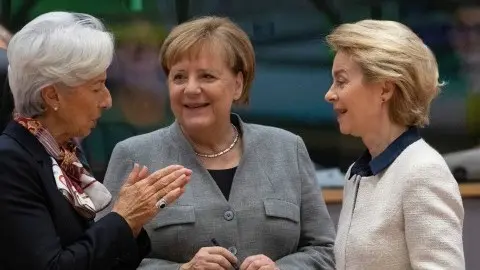Eurozone: Is this recovery for real?
There are gradually more signs that the eurozone economy is bottoming out after a deceleration that started in January 2018. However, survey data seems to reflect some hope for improvement, while hard data still remains poor. Although the economy is likely to improve, 2020 is unlikely to see much stronger growth than in 2019
Trade to the rescue?
For the economy to recover, we need to see the animal spirits reviving. Although sentiment indicators have indeed improved over the last few months, we don’t see much progress in hard data yet.
To be sure, the German Ifo-indicator rose for the third month in a row in November, while the European Commission’s economic sentiment indicator registered a stronger than expected increase last month. The €-coin indicator, a real-time estimate of the underlying growth pace, rose slightly from 0.13 in October to 0.15 in November, although this still suggests rather weak growth. There is hope that trade could offer some relief in 2020.
As a matter of fact, the eurozone is a far more open economy than both China and the US, explaining why the fall in global trade on the back of the trade war provoked significant collateral damage in Europe. Other positive news was the fact that President Donald Trump didn’t announce higher tariffs on European cars. This would have been an additional blow to the already battered German car industry. Finally, Boris Johnson’s landslide victory in the UK elections offers at least the advantage that there will now be more clarity on Brexit, although the negotiations for a new trade deal between the UK and the EU might still prove to be laborious.
Real data still weak
While the news flow has certainly been improving, a robust upturn is not to be expected. The more cyclical business climate indicator even decreased to -0.23 from -0.20 in October. This chimes with a further fall in the assessment of order books in the industrial sector. Employment expectations declined in all sectors in November, which might have a dampening effect on consumption. Several big German firms announced significant lay-offs over the last month.
Admittedly, the German unemployment figures remain reassuring, but such headline news might make consumers more cautious. Eurozone rail sales actually dropped by 0.6% month-on-month in October, after a 0.2% contraction in September. One of the other first 4Q real indicators also looked rather bleak. Industrial production in the eurozone fell 0.5% month-on-month in October, after a 0.1% decline in September, so the fourth quarter has already started on a rather weak footing.
Weak real data

Structurally low growth
That is the reason why we remain quite cautious in our growth outlook. We are looking at quarterly growth rates for the eurozone close to 0.1% in both the last quarter of 2019 and the first quarter of 2020. Even with a gradual acceleration from 2Q20 onwards, we think the eurozone will struggle to achieve a growth rate above 1.0% next year. We pencil in 0.7% GDP growth in 2020 and 1.1% in 2021.
We pencil in 0.7% GDP growth in 2020 and 1.1% in 2021
For the time being there is little reason to expect a change in the subdued growth story, which seems to be of a more structural nature. With labour force growth further slowing over the coming years and productivity gains rather subdued, the growth potential in the eurozone is definitely not going to be more than 1.5% and is probably closer to 1.0%. While there are always doubts about the computation of the size of the output gap, there is probably only a small negative output gap left, meaning that GDP growth will be at best only slightly above-potential growth in the coming years.
The ambitious green deal announced by the new European Commission might raise hopes of higher investment in the future, but this is likely to be spread out over a very long period, which means that it would only have a marginal effect in the near future.
Inflation remains subdued
Inflation increased from 0.7 to 1% in November with core inflation rising from 1.1 to 1.3%. Except for energy prices, all the underlying series increased, with the largest jump happening in services prices. Could this be the start of an upward trend?
Looking at wage dynamics, which have been strengthening over the last year, it is tempting to say that the Phillips curve is finally reasserting itself with the tighter labour markets finally leading to stronger inflation. However, this process is unlikely to gain much traction over the coming year.
As a matter of fact, in the consumer surveys, labour market perspectives have been deteriorating over the last few months, a phenomenon that is likely to temper wage inflation. At the same time, selling price expectations have been falling in both industry and services - a sign that eurozone businesses still have little pricing power. To be sure, we think that inflation is likely to creep higher, but it will happen at a snail’s pace. Both for 2020 and 2021 it still looks unlikely that average inflation is going to come out above 1.5% - and that is more or less also the ECB’s assessment.
In the introductory statement to the December press conference, the ECB president Christine Lagarde said “measures of underlying inflation have remained generally muted, although there are some indications of a mild increase in line with previous expectations. While labour cost pressures have strengthened amid tighter labour markets, the weaker growth momentum is delaying their pass-through to inflation”. The ECB staff now expects inflation to come in at 1.1% in 2020, 1.4% in 2021 and 1.6% in 2022.
Little pricing power

Steady as she goes
With inflation still short of the ECB’s objective, you could argue that the ECB will have to do more. But that doesn’t seem to be on the cards, as the strategic review which starts from January will examine, among other things the definition of inflation. E.g. the question whether housing should be included more prominently in inflation measures or not.
No hard conclusions are to be expected before December 2020, which probably means that in the meantime monetary policy will remain on hold. And we actually think that little change is to be expected over the next two years.
As for bond yields, we have the feeling that we are now past the low point. With monetary policy reaching its limits and more calls on fiscal policy, bond yields are likely to settle in a gentle upward trend. However, the short run is still likely to see some volatility, as the short term dataflow might temper the expectations on the strength of the upturn.
The eurozone economy in a nutshell
This publication has been prepared by ING solely for information purposes irrespective of a particular user's means, financial situation or investment objectives. The information does not constitute investment recommendation, and nor is it investment, legal or tax advice or an offer or solicitation to purchase or sell any financial instrument. Read more
Download
Download article
16 December 2019
ING’s Eurozone Quarterly: Is this recovery for real? This bundle contains 13 Articles